Table of Contents
- Executive Summary
- The Hidden Cost of Poor Onboarding
- What is an AI-Powered Digital Adoption Platform (DAP)?
- How AI-Powered DAP Accelerates Employee Onboarding
- Implementation Strategy: Getting Started with AI-Powered DAP
- Measuring Success: KPIs and Analytics
- Why Apty is the Ultimate AI-Powered DAP Solution
- Getting Started: Your Next Steps
- FAQs
- Key Takeaways
Executive Summary
Employee onboarding represents one of the most critical yet underoptimized processes in modern organizations. While 88% of organizations believe they onboard well, only 12% of employees agree. This disconnect presents a significant opportunity for mid-sized enterprises willing to adopt AI-powered solutions that transform onboarding from a necessary expense into a strategic competitive advantage.
The statistics paint a stark picture of the failure of traditional onboarding. Approximately 20% of new employees quit within 45 days, resulting in organizations incurring an average of 21% of the departing employee’s annual salary in replacement costs. For a mid-sized enterprise with 500 employees and 20% annual turnover, this represents over $2.1 million in direct replacement costs alone, before considering the hidden costs of lost productivity, knowledge drain, and customer impact.
AI-powered Digital Adoption Platforms (DAPs) are revolutionizing this landscape by delivering personalized, contextual guidance that accelerates time-to-productivity by 50-70% while reducing errors by 30% and support tickets by 25%. Organizations implementing AI-powered onboarding report 3.4x ROI within the first year, driven by faster employee productivity, reduced errors, and improved retention rates.
This comprehensive guide examines how mid-sized enterprises can leverage AI-powered DAP technology to create onboarding experiences that not only reduce costs but actively contribute to business growth. From implementation strategies to industry-specific applications, we’ll explore proven approaches that deliver measurable results within weeks rather than months.
Is your current onboarding approach costing your organization more than you think?
Use this Cost of Inaction Calculator to see how much your organization could be losing by sticking with ineffective training methods. It’s an easy way to identify the hidden costs of poor onboarding.
The opportunity is clear: organizations that master AI-powered onboarding will attract top talent, reduce operational costs, and build sustainable competitive advantages that become increasingly difficult for competitors to replicate.
The Hidden Cost of Poor Onboarding
The true cost of ineffective onboarding extends far beyond the obvious expenses of recruitment and training. Poor onboarding creates a cascade of hidden costs that compound over time, affecting everything from customer satisfaction to organizational culture and competitive positioning.
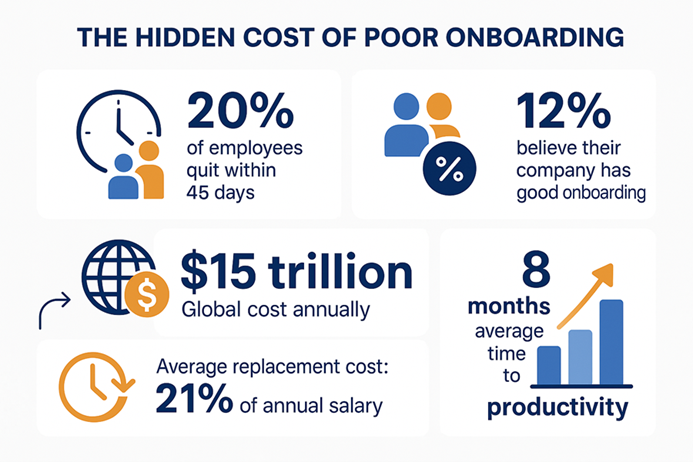
Direct Financial Impact
Turnover costs represent just the tip of the iceberg. While organizations typically calculate replacement costs at 21% of annual salary, this figure dramatically underestimates the total impact. The true cost of early turnover ranges from 50-200% of annual salary when including recruitment, training, lost productivity, and knowledge transfer expenses.
Consider a mid-sized enterprise losing 100 employees annually due to poor onboarding. With an average salary of $65,000, the direct replacement costs exceed $1.3 million. However, the hidden costs—lost productivity during the learning curve, customer relationship disruption, and team morale impact—often triple this figure.
Time-to-productivity delays create an ongoing revenue impact. Traditional onboarding approaches require 8 months for employees to reach full productivity, during which organizations pay full salaries while receiving diminished output. For knowledge workers earning $75,000 annually, each month of delayed productivity costs approximately $6,250 in lost value creation.
Operational Efficiency Degradation
Poor onboarding creates operational bottlenecks that affect entire teams and departments. New employees who lack proper guidance make more errors, require additional support, and often abandon complex tasks rather than completing them incorrectly. Organizations with ineffective onboarding report 67% higher error rates among new employees during their first six months.
Support burden escalation overwhelms IT and HR teams when new employees cannot effectively use business applications. Traditional onboarding generates 40% more support tickets per new employee compared to AI-powered approaches, diverting resources from strategic initiatives to routine problem-solving.
Process compliance failures create regulatory and operational risks. Manual training approaches achieve only 23% compliance rates for complex procedures, exposing organizations to regulatory violations, audit findings, and operational inconsistencies.
Want to see the return on investment of improving your onboarding process?
This ROI Calculator helps you measure the potential financial impact of adopting AI-powered onboarding. Understand how optimizing this process could boost your bottom line.
Also, you can take our DAP Strategy Readiness Assessment to understand where you stand in terms of adopting AI-powered onboarding and what steps are needed for a successful implementation.
What is an AI-Powered Digital Adoption Platform (DAP)?
Digital Adoption Platforms represent a fundamental evolution in how organizations approach software training and user support. Unlike traditional training methods that rely on static content and hope for knowledge transfer, AI-powered DAPs provide intelligent, contextual guidance directly within business applications where actual work occurs.
Core Technology Components:
Artificial Intelligence forms the foundation of modern DAP capabilities, enabling systems to understand user behavior, predict needs, and adapt guidance in real-time. Machine learning algorithms analyze millions of user interactions to identify optimal learning paths, common pain points, and opportunities for process optimization.
Natural Language Processing (NLP) capabilities enable DAPs to understand user intent and provide conversational guidance that feels natural rather than robotic. Advanced NLP systems achieve 94% accuracy in understanding user questions and providing relevant responses, creating support experiences that rival human assistance.
Computer Vision technology allows DAPs to understand application interfaces at a granular level, recognizing buttons, fields, menus, and workflows across different software environments. This visual understanding enables precise guidance that adapts automatically when applications update or change.
How AI-Powered DAP Accelerates Employee Onboarding
The transformation from traditional onboarding to AI-powered acceleration represents a fundamental shift in how organizations approach employee integration. Rather than hoping employees will remember training content and apply it correctly, AI-powered DAPs create intelligent, adaptive experiences that guide employees to success while continuously optimizing the learning process.
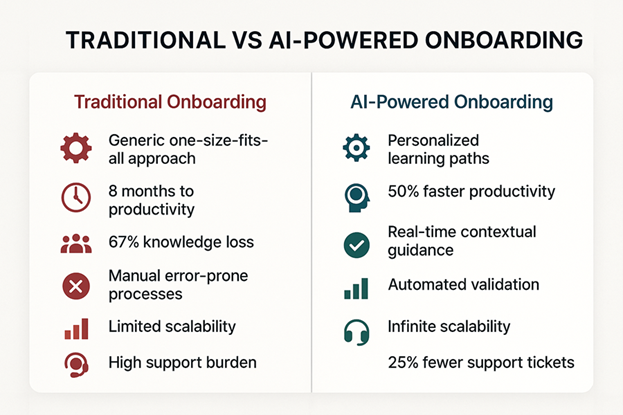
Personalized Learning Experiences at Scale
Traditional onboarding treats all employees as identical learners, delivering the same content in the same sequence regardless of individual needs, experience levels, or learning preferences. This one-size-fits-all approach fails to account for the reality that every employee brings unique backgrounds, skills, and learning styles to their new role.
AI-powered DAPs revolutionize this approach through sophisticated personalization engines that analyze multiple data points to create individualized learning paths. The system considers the employee’s role, department, previous experience, demonstrated proficiency levels, and even learning pace preferences to customize every interaction.
Machine learning algorithms continuously analyze user behavior patterns to identify optimal learning sequences for different employee types. If data shows that employees with financial services backgrounds learn CRM systems 40% faster when starting with customer data management rather than sales processes, the system automatically adjusts the learning path for similar new hires.
In-Application Support and Contextual Guidance
The most significant advancement in AI-powered onboarding is the shift from external training to contextual, in-application support. Rather than requiring employees to learn in artificial training environments and then transfer knowledge to real work situations, AI-powered DAPs provide guidance within the actual business applications where work occurs.
This contextual approach eliminates the cognitive burden of knowledge transfer. Traditional training requires employees to remember information from one context and apply it in another, resulting in 67% knowledge loss. In-application guidance eliminates this transfer requirement by providing support exactly where and when it’s needed.
See how in-app guidance can recover every dollar you spent on business applications.
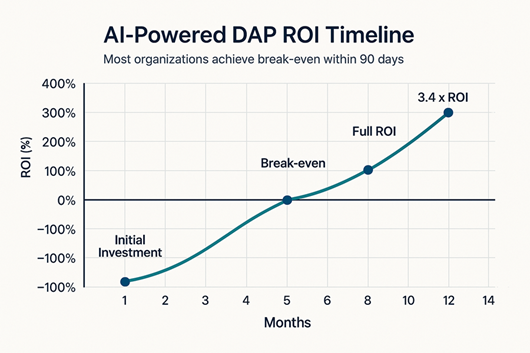
Industry-Specific Applications for Mid-Sized Enterprises
The power of AI-powered onboarding becomes most apparent when examining how different industries leverage these technologies to address their unique challenges and requirements. Mid-sized enterprises across various sectors are discovering that generic onboarding approaches cannot address the specialized knowledge, compliance requirements, and operational complexities that define their competitive landscapes.
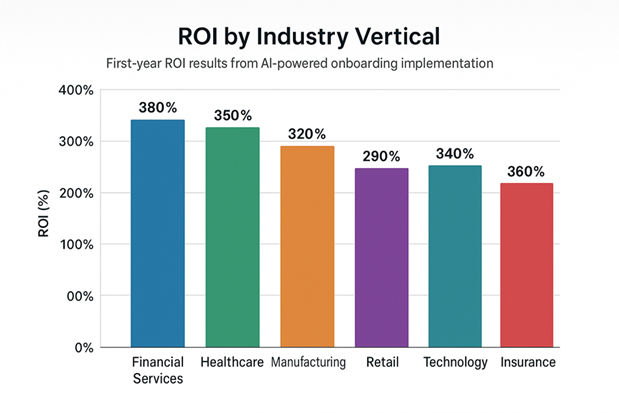
- Banking and Financial Services: Compliance-First Onboarding
The financial services industry presents perhaps the most complex onboarding challenges, combining sophisticated technology systems with stringent regulatory requirements and high-stakes decision-making processes. Financial institutions face an average of 47 different regulatory requirements that must be incorporated into employee training, making traditional approaches inadequate for ensuring consistent compliance.
AI-powered DAPs transform financial services onboarding by embedding compliance guidance directly into business applications. Rather than hoping employees remember regulatory requirements from training sessions, the system provides real-time compliance checking and guidance within actual banking systems.
- Healthcare and Insurance: Accuracy-Critical Operations
Healthcare organizations face unique onboarding challenges that combine life-critical accuracy requirements with complex regulatory environments and rapidly evolving technology systems. Medical errors cost the U.S. healthcare system $20 billion annually, making effective training a patient safety imperative rather than just an operational efficiency goal.
- Manufacturing: ERP Mastery and Safety Compliance
Manufacturing organizations face complex onboarding challenges that combine sophisticated Enterprise Resource Planning (ERP) systems with critical safety requirements and quality control procedures. Manufacturing ERP systems typically include 200+ different functions, making comprehensive training a significant challenge for traditional approaches.
Implementation Strategy: Getting Started with AI-Powered DAP
The journey from traditional onboarding to AI-powered excellence requires strategic planning, careful execution, and commitment to continuous improvement. While the technology capabilities are impressive, success depends on thoughtful implementation that aligns with organizational culture, business objectives, and change management best practices.
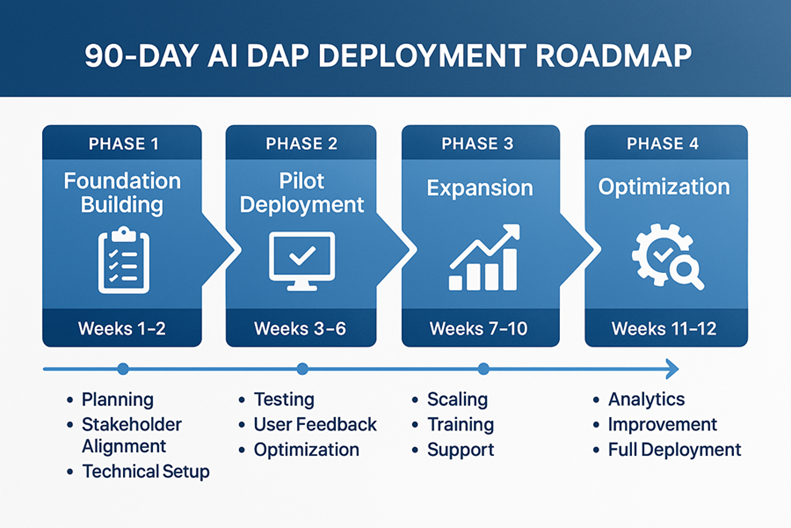
Assessment and Planning: Building the Foundation
Successful AI-powered DAP implementation begins with a comprehensive assessment of current state capabilities, future state vision, and the gap between them. Organizations that invest adequate time in planning achieve 67% better implementation outcomes compared to those that rush into deployment without proper preparation.
The current state assessment should examine existing onboarding processes, technology infrastructure, employee satisfaction levels, and business impact metrics. This baseline establishes the foundation for measuring improvement and identifying priority areas for initial focus.
Not sure where to begin with implementing AI-powered onboarding?
Conduct a thorough Organizational Readiness Assessment to understand the current gaps in your training and onboarding processes. This is the first step in transforming onboarding into a strategic tool for growth.
Phased Implementation Approach: Start Small, Win Quickly
The most successful AI-powered DAP implementations follow a phased approach that demonstrates value quickly while building organizational confidence and capability. Organizations using phased approaches achieve 89% success rates compared to 34% for big-bang implementations.
Phase 1: Pilot Program (Weeks 1-4)
The pilot phase focuses on a single, high-impact use case that can demonstrate clear value within 30 days.
Phase 2: Departmental Expansion (Weeks 5-8)
Based on pilot success, the second phase expands AI-powered onboarding to entire departments or business units.
Phase 3: Organization-Wide Deployment (Weeks 9-12)
The final phase extends AI-powered onboarding across the entire organization.
Measuring Success: KPIs and Analytics
The transition to AI-powered onboarding creates unprecedented opportunities for data-driven optimization and continuous improvement. Unlike traditional training approaches that rely on subjective assessments and delayed feedback, AI-powered DAPs provide real-time analytics that enable immediate course correction and ongoing enhancement of the onboarding experience.
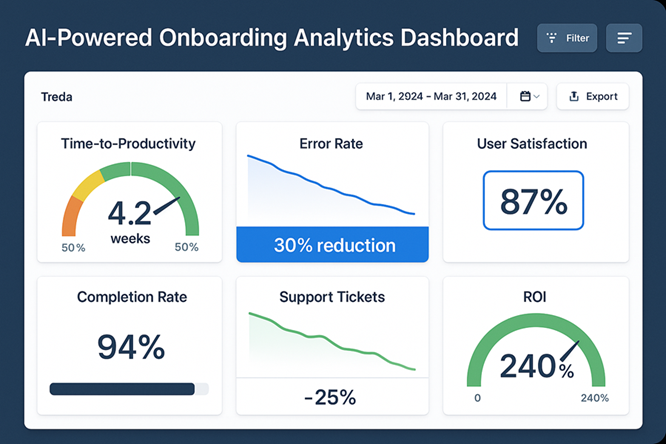
Key Performance Indicators for AI-Powered Onboarding
Effective measurement requires a balanced approach that captures both immediate learning outcomes and long-term business impact. Organizations with comprehensive KPI frameworks achieve 78% better optimization results than those focusing on single metrics or limited measurement approaches.
- Time-to-Productivity Metrics
Time-to-productivity represents the most critical measure of onboarding effectiveness, directly correlating with business value creation and employee satisfaction. AI-powered onboarding should reduce time-to-productivity by 50-70% compared to traditional approaches, with measurement occurring at multiple competency levels.
- Learning Effectiveness Indicators
Knowledge retention rates measure how well employees maintain learned information over time. AI-powered onboarding should achieve 85%+ retention rates at six-month intervals, significantly higher than traditional training approaches.
- Business Impact Measurements
Error rates during the onboarding period provide direct measures of training effectiveness and business risk. Target error reduction of 40-60% compared to traditional onboarding represents typical success levels for well-implemented AI-powered systems.
Why Apty is the Ultimate AI-Powered DAP Solution
In a crowded market of digital adoption platforms, Apty stands apart through its fundamental philosophy: “Software should work for people. Apty makes sure it does.” This isn’t just marketing rhetoric; it represents a fundamentally different approach to solving the enterprise software adoption challenge that has frustrated organizations for decades.
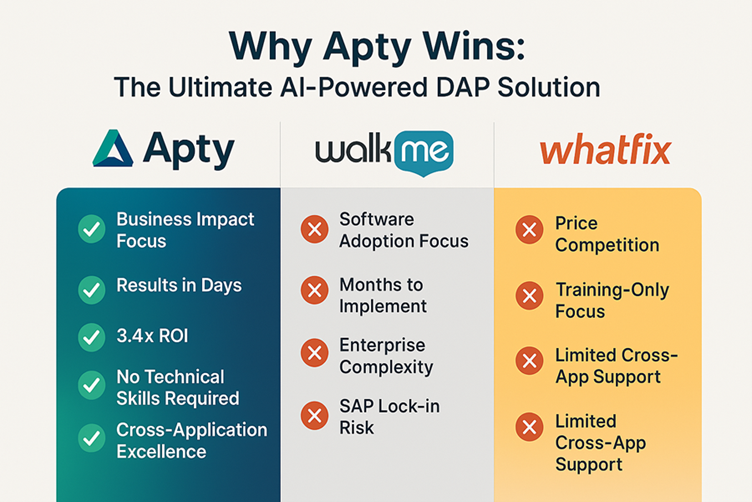
- Apty’s Unique Value Proposition: Business Impact Over Software Adoption
While most DAP vendors focus on software adoption metrics—clicks, page views, feature usage—Apty focuses on what actually matters to business leaders: measurable business outcomes that impact the bottom line. This distinction transforms how organizations think about digital adoption from a training problem to a business optimization opportunity.
- The Practical Promise: Results in Days, Not Months
Traditional DAP implementations require months of setup, specialized technical skills, and extensive customization before delivering any value. Apty delivers measurable results within 14 days, with full implementation typically completed in 2-4 weeks rather than months.
This speed advantage stems from Apty’s implementation methodology that focuses on high-impact processes first. Rather than trying to guide every possible user action, Apty identifies the 20% of processes that drive 80% of business value and optimizes those first. Organizations see immediate ROI while building confidence for broader deployment.
- Proven Results and Competitive Advantages
Apty’s focus on business outcomes produces consistently superior results across key performance indicators. Organizations using Apty achieve 3.4x ROI in the first year, driven by multiple value streams that compound over time.
Onboarding acceleration represents the most visible benefit. New employees reach productivity 50% faster with Apty guidance, reducing the costly unproductive period that affects every new hire. For mid-sized enterprises hiring 100+ employees annually, this acceleration creates millions in additional productive value.
Compare various DAPs in depth in the following articles:
Getting Started: Your Next Steps
The journey from traditional onboarding to AI-powered excellence begins with a single step, but success requires strategic planning and systematic execution. Organizations that achieve the best results follow proven pathways that minimize risk while maximizing early wins and long-term value creation.
- Organizational Readiness Assessment
Before implementing any AI-powered DAP solution, organizations must honestly evaluate their current state and readiness for transformation. This assessment prevents 73% of common implementation problems by identifying and addressing potential obstacles before they become blocking issues.
- Implementation Planning and Timeline
Phase 1: Foundation Building (Weeks 1-2)
The foundation phase establishes project governance, stakeholder alignment, and technical prerequisites.
Phase 2: Pilot Deployment (Weeks 3-6)
The pilot phase focuses on a single, high-impact use case that can demonstrate clear value quickly.
Phase 3: Expansion and Optimization (Weeks 7-12)
Based on pilot success, the expansion phase extends AI-powered onboarding to additional departments or processes.
FAQs
Key Takeaways
The transformation from traditional employee onboarding to AI-powered excellence represents more than a technology upgrade—it’s a strategic imperative that determines competitive positioning in an increasingly talent-driven economy. Organizations that master AI-powered onboarding gain sustainable advantages in talent acquisition, development, and retention that compound over time.
The evidence is overwhelming: AI-powered Digital Adoption Platforms deliver 3.4x ROI within the first year while creating measurable improvements across every dimension of employee experience and business performance. From 50% faster time-to-productivity to 30% error reduction to 25% fewer support tickets, the benefits extend far beyond training efficiency to fundamental business transformation.
Mid-sized enterprises face a unique opportunity. Unlike large corporations constrained by complex approval processes and legacy system dependencies, mid-sized AI development companies can implement AI-powered onboarding quickly and see immediate results. Unlike small companies with limited resources and simple technology needs, mid-sized enterprises have the complexity and scale to realize substantial benefits from intelligent automation.
Every day without AI-powered onboarding is a day of wasted productivity and lost revenue. While competitors struggle with traditional approaches that achieve 12% employee satisfaction and 20% first-quarter turnover, forward-thinking organizations are creating onboarding experiences that generate 69% three-year retention rates and 18x higher employee dedication.
Apty represents the ultimate solution for organizations ready to transform their onboarding capabilities. Unlike competitors that focus on software adoption metrics, Apty delivers measurable business execution that impacts the bottom line immediately. The platform’s practical promise—results in days, not months—eliminates the risk and complexity associated with traditional DAP implementations.
The choice is clear: continue accepting the hidden costs of ineffective onboarding, or join the growing number of mid-sized enterprises that have discovered the competitive advantage of AI-powered employee development. The organizations that act now will define the competitive landscape for years to come.
Your next step is simple: Book a demo with Apty and discover how AI-powered onboarding can transform your organization’s talent development capabilities. The future of employee onboarding is here—and it’s time to claim your competitive advantage.
